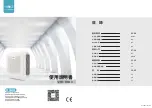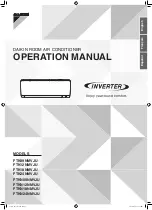
The time required for PTC to heat to a sufficient point controls ON
timing of device. The time required for disc to cool down when
power is removed controls OFF time of device. The PTC can be
varied to provide varied timing. Typically a short ON equates to a
long OFF.
Because this is a thermally-activated device, ambient conditions
affect the ON/OFF cycle. Higher ambient temperature means
shorter ON times and longer OFF times.
These sequencers may be "ganged up" to 3 on a common mounting
plate to control up to 6 heater elements. In this situation, PTCs are
different in each sequencer to provide a staged ON of a minimum
of 10 sec between each sequencer — 3 stages of 2 elements since
the KFA and KFB series heaters use sequencers in which both
switches of the 2-pole sequencer close simultaneously. Older
models used sequencers which had a minimum delay of 10 sec
between each switch.
Application of these devices is such that the first switch ON not
only turns on first heater element, but also ensures that indoor fan
is energized, because first ON is last OFF. This ensures fan
remains ON until the last heater de-energizes.
KFC AND KFD ELECTRIC HEAT RELAY
KFC and KFD electric heater packages have relays controlling the
heater elements instead of sequencers. A small rectifier PCB is
mounted to each relay which converts the incoming 24-vac control
signal to dc. In addition to the rectifier circuit, the second and third
stage relays contain a time-on delay circuit of 5 seconds for second
stage, and 8 seconds for third stage. When the control signal is
removed from the relays, all relays will open with no time-off
delay.
Step 2—Troubleshooting KFA, KFB, KFC, and KFD
Series Electric Heaters
DISCOLORED WIRE INSULATION AT TERMINAL
Check quick-connect terminal at discoloration. Connection may be
loose, creating a high resistance through connection point.
FUSE FAILURE
1. Check for shorted wire. Replace wire. Never try to fix wire
using electrical tape.
2. Check shorted element. If element is shorted, replace heater.
NO HEAT
1. Check fuse for failure. If fuse has failed, refer to Fuse Failure
section.
2. Check for faulty transformer. Check output voltage of trans-
former secondary side R (red) and C (brown). Make sure
output is between 18 and 30 vac. If output voltage is low and
input voltage tests normal, replace transformer.
3. Check for miswired heater plug harness.
4. Check limit switch or sequencer failure. These switches
should have failed in open position. If output voltage is zero
volts, replace switch.
5. Check heater relay and PCB (KFC and KFD heaters only).
Control voltage input to PCB should be 24-vac. Output to
relay should be 18-vdc minimum. If input is present but no
output, replace PCB. If output is present, replace relay.
HEATER WILL NOT TURN OFF
1. Check low-voltage wiring for miswire.
2. Check for shorted elements to ground.
3. Replace sequencer/relays. They may be stuck closed.
NUISANCE TRIPS
1. Check for low airflow due to dirty filters, blocked registers, or
undersized duct.
2. Check blower motor and wheel for proper operation. Exces-
sive current draw of motor will cause internal overload to trip.
3. The fan speed may be low.
FAN COIL DESCRIPTION
AND TROUBLESHOOTING
FK4B
The FK4B is similar to the discontinued FK4A as they have both
integrated controls and motor (ICM) and their own special circuit
board. The greatest difference between the 2 models is the way
each goes about delivering air.
Setting up desired airflow on the FK4B is obtained by the
selections made on Easy Select™ circuit board. The motor delivers
requested airflow as defined by signals received from Easy Select
Board and its internal programming. The major difference is that
the FK4B motor reacts to changes in system static pressures to
maintain constant airflow.
Unlike conventional fan coils where static pressure affects airflow,
the FK4B is a constant airflow unit. The blower delivers requested
airflow up to about 0.7 in. of static pressure. The ICM2 is
pre-programmed and contains airflows for all modes of operation.
Blower characteristics (airflow, torque, and speed-vs-static pres-
sure) are known from laboratory testing. If any 3 characteristics are
known, the fourth is defined.
Requested airflow is known because of Easy Select board con-
figuration and thermostat signals. Torque is known because it is
directly related to armature current which is measured by motor
control. Speed is measured from its generated back EMF. This
information is entered into an expression which calculates torque
from speed and airflow numbers. If calculation does not match
stored blower characteristics, torque is adjusted every 0.8 sec until
agreement is reached. The unit does not directly measure static
pressure, but does react to a change in static to maintain constant
airflow.
Step 1—Integrated Controls and Motor (ICM2)
The ICM2 is similar to the ICM1 used in FK4A series units, but
cannot be used as a replacement without some modification to
FK4A unit. Consult SMB 93-0052 for motor conversion kit. The
electronics of motor are built into rear of motor, deriving the name
ICM. (See Fig. 15.)
An ICM is first fed high voltage AC power through the 5-pin
connector. The AC power is then rectified to DC by a diode
module. After rectification, DC signal is electronically communi-
cated and fed in sequential order to 3 stator windings. The
frequency of communication pulses determines motor speed. The
rotor is permanently magnetized.
An ICM is powered with high voltage at all times. The motor will
not run with high voltage alone. Low voltage must be applied to
control plug to run motor.
Step 2—PCB Layout and Description
NOTE:
Layout of actual PCB is depicted in Fig. 16 and 17.
The control is a single PCB which interfaces a variable-speed
ICM2 with other system components.
Power for system is supplied from a 230-vac, 60-Hz line. Class 2
voltage (24 vac nom.), used for thermostat connections, is derived
from a transformer located in close proximity to control. The
primary and secondary of transformer are connected to control
board. The 24-vac secondary circuit includes a socket, soldered
into circuit at SEC2, to receive a 5-amp automotive-type fuse.
20
















































